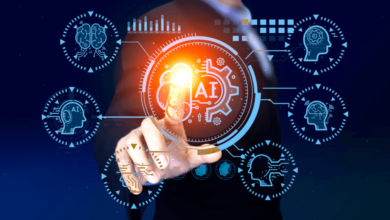Often thought of as the silver bullet that will transform the business and accelerate success, government research shows companies across the UK are set to increase expenditure on AI technologies to between £27.2 billion and £35.6 billion by 2025. Despite this growing appetite for transforming business processes through AI innovation, many businesses still struggle to unleash the full potential of responsible and ethical AI breakthroughs.
Any successful endeavor — from house building to digital transformation — requires the establishment of strong foundational knowledge, and this holds true when trying to unlock AI and produce positive, actionable outcomes. However, many companies battle to get past some of the more common AI myths and misconceptions. Further stalling the opportunity to unlock the enormous potential of innovative AI applications to provide business growth and societal benefits. While even the smartest technologies can’t deliver everything they are promised to do, these five misconceptions are nothing short of myths that need to be debunked once and for all.
1. With artificial intelligence, all problems will disappear into thin air
The idea that AI technologies and applications are machines that you simply plug in for better results, such as increasing sales revenue or automating processes to reduce costs, is little more than a myth.
While AI promises great things, organisations that go into AI and ML with grand dreams of instant success often find that reality falls short. AI and ML are certainly transformative technologies in nature; successful deployment requires understanding the overall goals and possible risks. For AI to gain a strong, widespread foothold across the business, it should be based on a gradual, incremental process built on a foundation of data-centric projects. Organisations should start with gradual, incremental projects like increasing customer satisfaction using conversational AI chatbots for automating repetitive customer technical support processes. Over time, as capabilities and understanding of AI grow within departments, AI can be used to tackle more significant challenges.
2. Machine learning is about thinking like a human being
In fact, the opposite is the case – AI is not supposed to think like humans. And with good reason: Humans are complex creatures, and our brains are incredibly complicated – our brain is exposed to vast amounts of information daily; it has to filter out what is important and what is unimportant. We use heuristics all the time, ‘rules of thumb’ that we’ve learned with years of experience. We learn stereotypes that allow us to make snap judgements but aren’t necessarily correct.
We don’t want computers to think like humans because humans have faulty thinking. The truth is that machine learning is about making predictions from data. If that data is of poor quality, the results won’t be objective. There’s data, and there’s good data. Data often comes with some form of bias, whether intentionally or not. Age, race, gender, health history, financial standing, income, location, and more can produce bias – in fact, any data can introduce bias. Machine learning simply learns biases in the data, and the assumptions the team make. Why does this matter? Bias in algorithms, data and the team can result in measurable losses to the business. For example, banks use AI to make decisions about who to lend money to. Who is a risk? Who will be more likely to pay back their loan on time? We know that much data is biased, so machine learning based on that data will be flawed too. Training, testing, and continual monitoring are integral to AI success.
3. Machine Learning can predict the future
This one is true, but only if the future is like the past. In short, ML is trained on historical data and makes predictions based on the theory that the same thing will happen again. While AI-based models can help companies prepare for different scenarios based on similar events happening in the past. There’s more to ML than just making predictions. Business leaders can use it to create business forecasting insights and simplify processes for new efficiencies. If you don’t use ML to change the behaviour of your business decisions, what’s the point?
4. The more data, the better the result
There’s data, and there’s quality data. There’s no point putting in vast amounts of data if it’s wrong, incomplete, there’s too small a sample, or if it’s recording the wrong information altogether. The results will reflect the input so: Garbage In = Garbage Out. Data scientists say that about 80% of their role is cleansing and preparing data, and there’s a reason for that. Even the cleverest machine can’t create insights from inaccurate data. Successful AI/ML implementation does not happen overnight. The most innovative organisations take a multi-year approach to data strategies and upskilling diverse teams that incorporate AI experts, data scientists and line-of-business analysts. Since AI data design requires “data speak” to help build pipelines, organisations must empower every human member of their business to be data literate and think about how to leverage the technology.
5. AI and ML will replace humans in the long run
From 2001 Space Odyssey to Terminator to I, Robot, numerous Hollywood films have fuelled our imagination of what our world might one day be like, every time there’s a big threatening AI. However, we are a long way from that version of reality. Successful AI development must keep humans in the loop, incorporate human judgment and accountability, and inform decisions appropriately. One study showed that 38% of people expect technology such as AI to eliminate workplace jobs in the next three years. It’s predicted that by 2030, there will be up to 20 million jobs lost to robots in the manufacturing sector. While these are some scary numbers, the truth is that AI and ML will augment people by taking tedious, repetitive tasks and allowing people to get on with creative, unpredictable, more complex tasks. By working hand in hand with humans, responsible and ethical AI will build the actionable insights needed to help automate manual and tedious work and make positive changes in the workplace.
When done well, the business outcomes from a data science approach to AI innovation could be all those things promised. Futureproofing by building faster, better, stronger – the superman of organisations. But to do so requires a data-centric strategy at the forefront. The successful use of AI on an organisational level requires combining unlocking access to data with initiatives to educate, upskill and reskill people in data literacy. Only then will it gain a broader understanding of what AI can do and where it will be most beneficial. While that may not sound as enticing (and easy) as plug-and-play-to-predict-the-future, it’s a far more successful strategy to be realistic about what AI can do and apply it judiciously to well-defined projects with great data.





